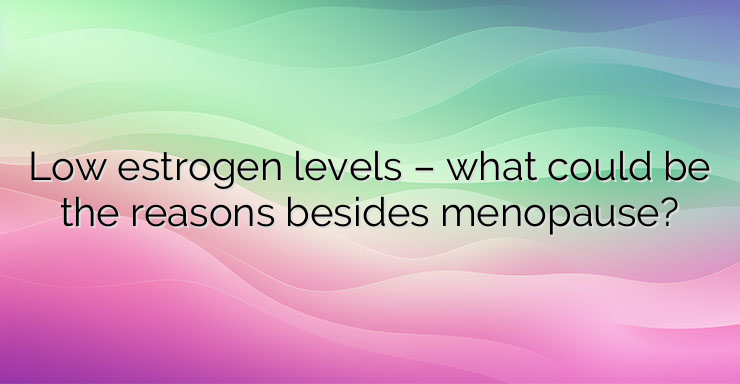Low estrogen is a normal part of aging, but low levels at a younger age can be associated with atypical sexual development. Estrogen is an important hormone that stimulates sexual development and helps maintain the reproductive system. It plays an essential role in other body systems as well. Estrogen levels rise and fall throughout life, often in sync with other hormones that control important body processes, such as the menstrual cycle. The ever-changing highs and lows associated with estrogen levels are normal. Having estrogen levels that are consistently low is different. Persistently low estrogen may mean a woman is going through a natural change, such as menopause. Sometimes low estrogen is a sign of a condition that delays sexual development, which can make it difficult to get pregnant. Everyone’s bodies produce estrogen, but women are most often affected by fluctuating levels. Low estrogen levels are seen in: Menopause or postmenopause. The ovaries produce most of the estrogen during the reproductive years. During menopause and postmenopause, the menstrual cycle stops and the ovaries no longer produce estrogen. Instead, fat cells begin to produce most of the body’s estrogen. Menopause officially begins when a woman reports no menstrual bleeding for twelve consecutive months. Postmenopause is the period that follows. Removal of the ovaries. The body will only produce small amounts of estrogen if the ovaries are removed as part of treatment for a condition (for example, during surgery to treat cancer). Similarly, radiation therapy can damage the ovaries so that they produce small amounts of estrogen. How does low estrogen affect the female body? Low estrogen can affect the body in different ways, depending on what stage of sexual development a woman is at. It can delay puberty, delay or prevent sexual development. Appears in perimenopause and menopause, often leading to painful intercourse, lower sexual desire and hot flashes. Symptoms associated with low estrogen in the reproductive years overlap with common symptoms associated with menopause and postmenopause. These will depend on what is causing the low estrogen levels. The most common cause of low estrogen is age. It’s natural for estrogen levels to drop as we age. Low levels unrelated to menopause can be a sign of a condition. Estrogen levels decrease during menopause. At this point, the main form of estrogen in the body switches from estradiol (produced primarily in the ovaries) to estrone (produced primarily in body fat). Eating disorders such as anorexia and bulimia can deprive the body of the nutrients it needs to keep hormone levels balanced.Turner syndrome and fragile X syndrome are causes of low estrogen levels. Autoimmune diseases that attack the ovaries can prevent them from producing enough estrogen. Primary ovarian failure, also known as premature menopause. In this condition, the ovaries stop producing eggs before the age of 40. Cancer treatments, such as radiation therapy and chemotherapy, can damage the ovaries. The injury can prevent the ovaries from secreting normal levels of estrogen. Removal of one or both ovaries (oophorectomy) as part of treatment can also lead to low estrogen levels. References: 1. Collins BC, Laakkonen EK, Lowe DA. Aging of the musculoskeletal system: How the loss of estrogen impacts muscle strength. (https://pubmed.ncbi.nlm.nih.gov/30930293/) Bone. 2019 2. Franco OH, Chowdhury R, Troup J, et al. Use of plant-based therapies and menopausal symptoms: a systematic review and meta-analysis. (https://pubmed.ncbi.nlm.nih.gov/27327802/) JAMA. 3. Harper-Harrison G, Shanahan MM. Hormone replacement therapy. (https://www.ncbi.nlm.nih.gov/books/NBK493191/) [Updated 2021 Jun 3]. In: StatPearls [Internet]. Treasure Island (FL): StatPearls Publishing


Leave a Reply